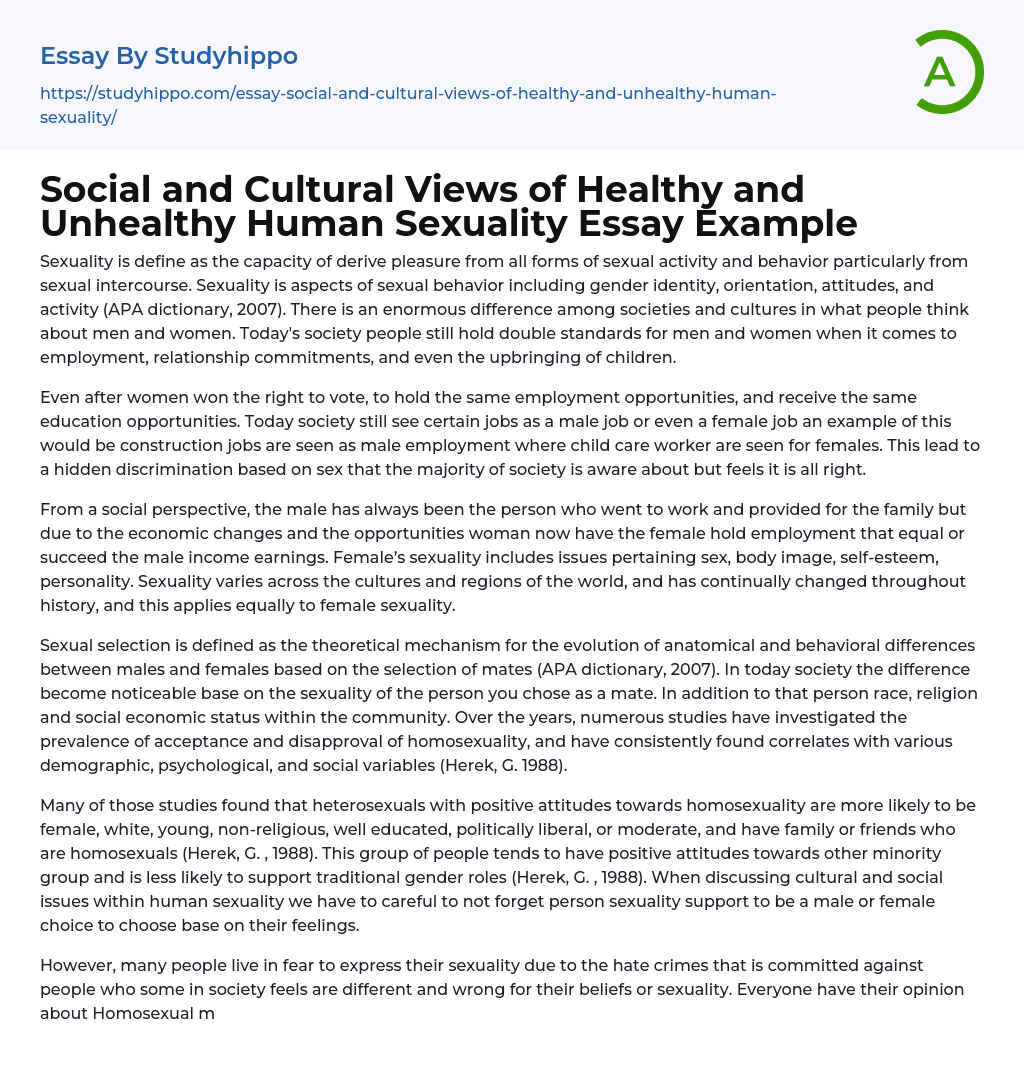

Social and Cultural Views of Healthy and Unhealthy Human Sexuality Essay Example
The 2007 APA dictionary defines sexuality as the capacity to derive pleasure from various sexual actions and behaviors, specifically sexual intercourse. This includes elements such as gender identity, orientation, perspectives, and activities. However, significant differences exist in societal and cultural views regarding men and women. Modern society continues to uphold unequal norms for both sexes in fields like career opportunities, responsibilities within partnerships, and child-rearing.
Even with advancements in female voting rights, equal job opportunities, and similar educational choices, contemporary society still tends to categorize certain professions as male or female. For example, building work is commonly viewed as a man's job while roles in childcare are often considered women's work. This quietly continues a gender prejudice that is broadly acknowledged yet seemingly embraced by the majority of society.
H
...istorically, males were often seen as the main financial providers for families. Nevertheless, due to changes in the economy and increased availability of opportunities, females now hold equivalent or sometimes even greater economic power than their male counterparts. Comprehending feminine sexuality includes elements such as sexual conduct, acceptance of one's body, self-assurance, and particular characteristics of personality. This understanding is not fixed; it alters across different cultural settings and locations worldwide. It has developed throughout history and continues to adapt in a manner similar to the concept of female sexuality.
Sexual selection theory elucidates the evolution of physical and behavioral disparities related to sex, which are influenced by mating choices (APA dictionary, 2007). Modern society brings these differences into sharp focus based on an individual's sexual orientation, choice of partner as well as their race, religion and socioeconomic standing. Numerou
researches over time have comprehensively analyzed societal perceptions towards homosexuality and discovered ties with diverse demographic, psychological and sociocultural factors (Herek, G. 1988).
A significant number of researches conclude that individuals of heterosexual orientation with favorable views on homosexuality are predominantly women, white, youthful, non-religious, highly educated, politically inclined towards liberalism or centrism, and possess gay family members or friends (Herek, G. , 1988). Such individuals often exhibit positive attitudes towards other marginalized groups and are less enthusiastic about endorsing conventional gender roles (Herek, G. , 1988). It's crucial to bear in mind when exploring cultural and social contexts in human sexuality that supporting one's sexual preferences, whether male or female, should be guided by personal emotions.
Despite this, numerous individuals are hesitant to disclose their sexual orientation due to the victimization and hate crimes committed against those perceived as different because of their beliefs or sexuality by some segments of society. People hold varying viewpoints regarding homosexual men, heterosexual women, and lesbians or gay women. These viewpoints span from attributing their sexual preference to familial genetics, religion, age, or considering it a transient social behavior aimed at acceptance among their younger counterparts.
Contemporary society often tends to view bisexual individuals, both men and women, through a negative lens, categorizing them as sexually immoral, manipulative, insincere, or indecisive due to their choice to engage in sexual relations with both genders (Herek, G., 1988). Various cultures frequently depict male bisexuals as living a secret life and female bisexuals as seeking emotions and experiences they lack with men, often attributed to negative past encounters with men. In my perspective, the most challenging demographic
to reach a consensus with on topics of human sexuality encompasses diverse religious communities.
- Anatomy and Physiology essays
- Addiction essays
- Biodegradation essays
- Dental Care essays
- Disease essays
- Disorders essays
- Health Care essays
- Intelligence Quotient essays
- Nutrition essays
- Olfaction essays
- Public Health essays
- Women's Health essays
- World health organization essays
- Cancer essays
- Infectious Disease essays
- Lung Cancer essays
- Neurology essays
- Physical Exercise essays
- Medicine essays
- Sex essays
- Inquiry essays
- Disability essays
- Poison essays
- Action Potential essays
- Nervous System essays
- Childbirth essays
- Puberty essays
- Blood essays
- Kidney essays
- Neuron essays
- Body essays
- Glucose essays
- Sense essays
- Heart essays
- Skeleton essays
- Human Physiology essays
- Eye essays
- Immune System essays
- Muscle essays
- Skin essays
- Brain essays
- Central Nervous System essays
- Human Skin Color essays
- Digestive System essays
- Common sense essays
- Respiration essays
- alcoholism essays
- Smoking essays
- Casino essays
- Tobacco essays



